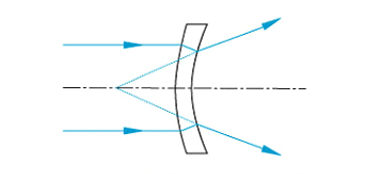Bent moon lenses are commonly used in multi-component optical systems to modify focal length without introducing significant spherical aberration. The optical performance of multi-element lens systems is usually significantly better than that of single lens systems. In these systems, aberrations introduced by one component can be corrected by subsequent optical components. These lenses have a convex surface and a concave surface, and they can be positive or negative lenses.
Positive crescent lens:
A positive meniscus lens is typically used in conjunction with another lens in composite optical assemblies. When used in this structure, a positive meniscus lens will shorten the focal length, increase the numerical aperture (NA) of the system, and will not introduce significant spherical aberration.
Negative crescent lens:
Negative crescent lenses are usually used together with another lens in composite optical assemblies. When used in this structure, a negative meniscus lens will increase the focal length and decrease the numerical aperture (NA) of the system.

| Key Specifications | |
| Material | Optical glass Optical crystal |
| Diameter | 3-650mm |
| Shape tolerance | ±0.015 |
| Surface Quality | 20-10 |
| Surface Flatness | λ/10 |
| Angle tolerance | <30″ |
| Effective aperture | 85% |
| Outer diameter | 25.40 |
|---|---|
| coating film | A:BBAR Ravg < 1% |
| material | H-K9L(Schott BK7) |
| design wavelength | 632.8nm |
| Focal length tolerance | ±1% |
| Profile Tolerance | +0.0/-0.1mm |
| Tolerance | ±0.1mm |
| Facial shape | λ/4@632.8nm |
| finish | 60/40 |
| eccentric | <3arc min |
| Effective aperture | >90% |
| Chamfer | <0.2×45° |
| effective focal length | 250.00 |
| Curvature radius R1 (mm) | 83.40 |
| Curvature radius R2 (mm) | 234.19 |
| back focal length | 247.35 |
| Center Thickness | 2.60 |
| Edge thickness | 2.00 |







![62569bc0cb5151[1]](https://asphericoptics.com/wp-content/uploads/2024/09/62569bc0cb51511.jpg)

Reviews
There are no reviews yet.